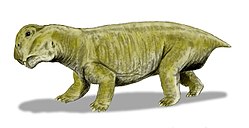| Otsheria Temporal range: Middle Permian, | |
|---|---|
 | |
| Life restoration of Otsheria | |
| Scientific classification | |
| Domain: | Eukaryota |
| Kingdom: | Animalia |
| Phylum: | Chordata |
| Clade: | Synapsida |
| Clade: | Therapsida |
| Suborder: | † Anomodontia |
| Genus: | † Otsheria Tchudinov, 1960 |
| Species: | †O. netzvetajevi |
| Binomial name | |
| †Otsheria netzvetajevi Tchudinov, 1960 | |
Otsheria is an extinct genus of anomodont, in the infraorder Venyukovioidea. It lived in modern-day Russia during the Permian. [1]
Contents
The genus is named for the Ochyor region where it was discovered in 1960, and the type species is Otsheria netzvetajevi. [2]
The holotype, a skull lacking a mandible (PIN 1758/5), is the only Otsheria fossil extant. The skull is 10.5 centimetres (4.1 in) in length, with large eye sockets and a short, broad snout. The skull suggests four incisors and nine short, flattened maxillary teeth. The canines are undifferentiated. The shape of the teeth and skull both suggest a mouth adapted for cutting plant parts, which in turn suggests a herbivorous or omnivorous diet. [3]






